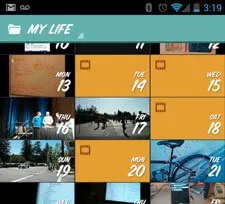· 4 min read Posted by Touchlab
Bringing An Awesome App to Life: 1 Second Everyday for Android


One of the coolest parts of being a mobile developer is getting the opportunity to build apps you’re excited to use yourself, which is why I’m thrilled to announce today’s launch of 1 Second Everyday’s Android app.
I’ve been a fan of 1SE since last year, when I watched creator Cesar Kuriyama’s popular TED talk. At 30, Cesar started recording one second of each day of his life so he would remember something about every single number on the calendar (and motivate himself to live a life worth capturing).
Check out this compilation of his 30th year here:
Touchlab’s app makes it easy for users to conjure up the same magic: they can record video of their day’s pivotal moment, and then edit it to isolate the exact second they want to capture. When they want to look back on their experiences, users can view compilations of the selected seconds in any increment of time they choose, from one month to one decade.
Completing 1 Second Everyday’s app took more time than expected — not to mention a serious dose of blood, sweat, and tears — but it was worth it to support such an awesome endeavor.
The new frontier
Until 1SE came along, Touchlab had never worked on an app with video editing capability (although we had created videos on a server and worked on plenty of video displays).
Luckily, I had an ace up my sleeve to help us make sense of the process: my brother, The Honorable Frank Galligan, runs the WebM video codec team at Google. Frank broke down the components of video encoding for us, basically distilling months of open source info that would have taken weeks to wade through.
But even with a video expert on hand to explain the basics, the execution was … intense. It would have been much easier to use VP8, WebM’s open source video compression format*, but we decided not to because it’s pretty much only supported on YouTube. To make sure our users can share the video on other platforms like Facebook, we had to stick with H.264.
Breakdowns and breakthroughs
Unlike iOS, Android doesn’t have much in the way of video editing capability built into its API. Over several weeks, we had to piece together various tools and techniques that would allow us to cut exactly one second of video, starting on an exact frame, and figure out how to merge them together in a reasonable time frame. Also, even we were surprised at the subtle variations of video output formats across manufacturers. In general, Android “fragmentation” is overblown, but video is very much an exception.
In addition to months of good’ ol trial and error, I credit our eventual success to two things:
The Touchlab team: without a razor sharp — and dedicated — team, this app would still be just a figment of imagination. The 1SE app is truly everybody’s baby, because the team shared in the collective head banging. When one team member got burnt out on video format hell, I assigned it to another so they could tackle it with fresh eyes.
One too many late nights: in particular, one 4AM epiphany in which I finally figured out how to seamlessly sync video and audio. (Sorry for the victory shouts, neighbors.)
Secret sauce
I’d love nothing more than to divulge the geeky details of how we made this app happen despite a steep learning curve and Android’s limited video editing capability — not to mention the surprising variation of video formats across manufacturers. But while I hope to share them very soon in the future, we’ve decided to keep the specific how-to underwraps for now so 1 Second Everyday can get some traction before 10 copy cats come out. (Plus: we’re a consulting company, and it’s always nice to make payroll.)
Despite the frustration, am I glad Touchlab took on the challenge? Hell yeah. Not only did we get the satisfaction of solving an intractable puzzle, but now we get to kick back and watch it impact users’ lives, second by second.
*Footnote: I really hope WebM takes off. Having a license-free codec, with pretty solid hardware optimization, would make life easier. vp9 compression is crazy. Watch this video: Its like ½ to ⅓ of what h264 can do (to be fair, h265 will probably be similarly awesome, but vp9 is coming sooner, and again — it’s free).
——————————————————————
Looking for a great team of focused Android experts to bring your idea to life? We do one thing: make Android apps. Keeping that focus means we can do things the right way. Let’s chat about your project, get in touch.
——————————————————————
Are you one of the best Android developers out there who likes solving problems, working on a small, agile team and building only the best solutions? Maybe we should talk, get in touch.